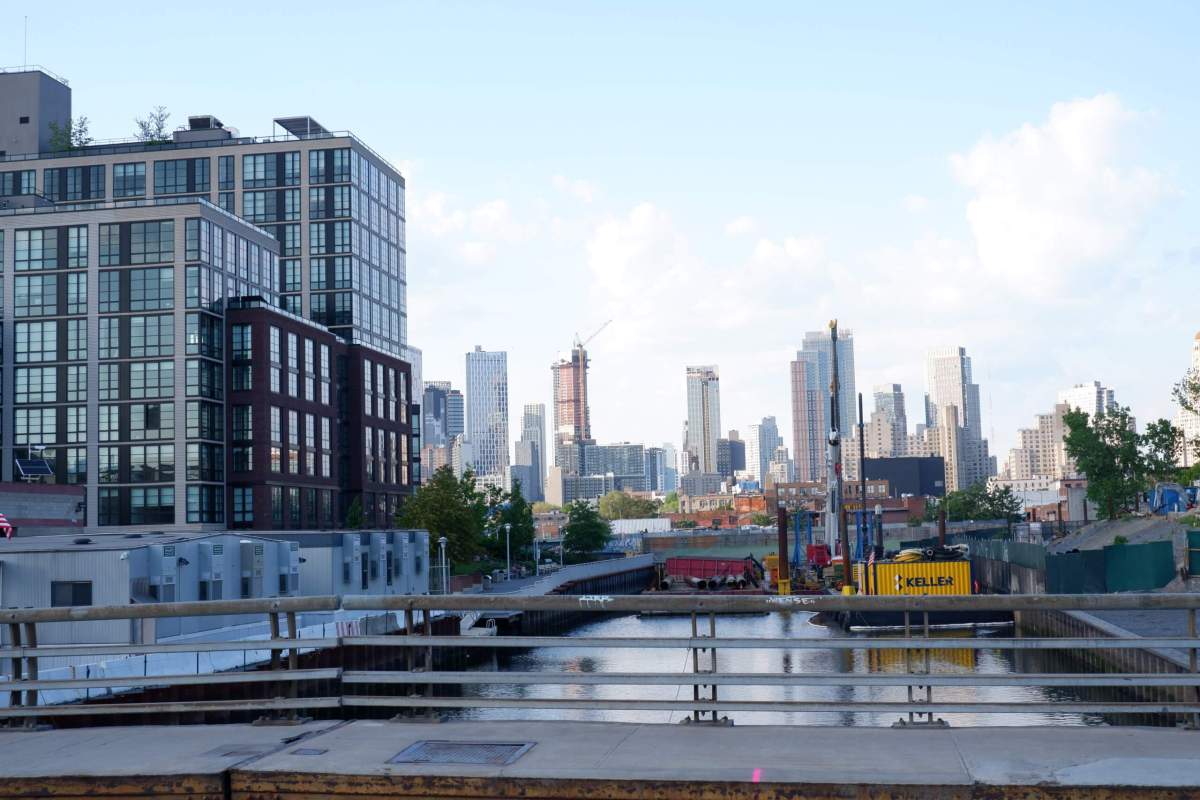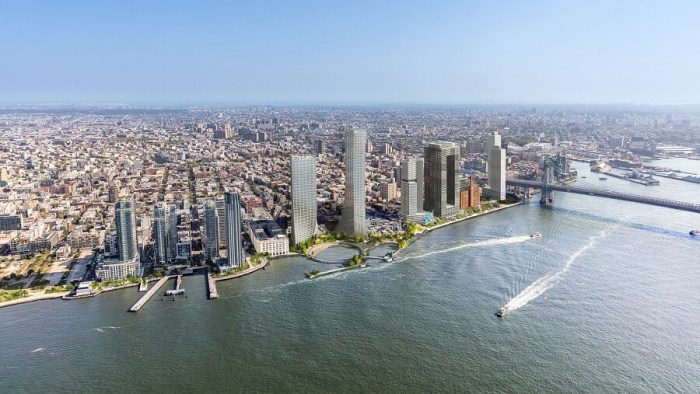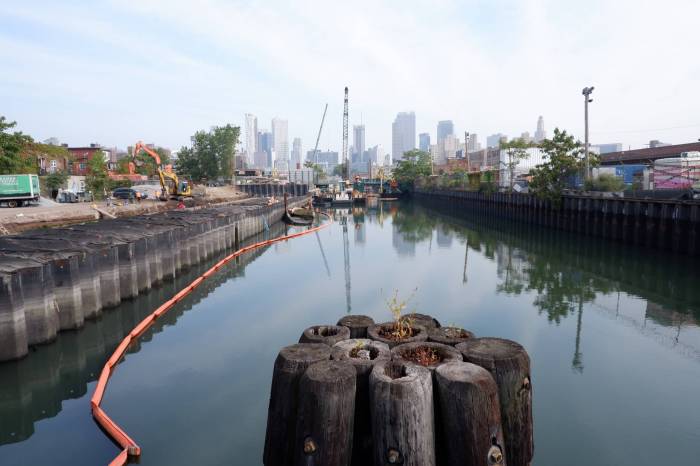The New York City Council voted nearly-unanimously on Tuesday to approve the Gowanus rezoning, officially setting the project in motion after years of planning and debate.
“It shows that many people will accept growth within their neighborhood if they are a real part of the planning process and see it as a way to achieve shared values,” said Councilmember Brad Lander, who represents the bulk of the district set to be upzoned. “This rezoning began nearly a decade ago in grassroots community conversations. It was strengthened through robust conversation in literally scores of meetings. It was strengthened through the advocacy of the remarkable Gowanus Neighborhood Coalition for Justice, a diverse coalition of public housing residents, environmentalists, artists, small businesses and community leaders.”
Lander highlighted the rezoning’s precedence — it’s the first rezoning to undergo a racial impact study and the first rezoning in a “whiter, wealthier neighborhood,” after the implementation of Mandatory Inclusionary Housing, which will ensure all new buildings have a number of affordable apartments.
Earlier this month, Mayor Bill de Blasio reached an agreement on the rezoning with Lander and Councilmember Stephen Levin, who represents part of Gowanus, and community groups including the Gowanus Neighborhood Coalition for Justice just ahead of the Council’s Land Use Committee vote. The agreement included parts of the three core demands laid out by GNCJ, which Lander and Levin both said needed to be included for the project to win their approval.
Those agreements included $200 million to fund improvements and repairs at Gowanus Houses and Wyckoff Gardens, two New York City Housing Authority complexes within the boundaries of the 82-block rezoning, and $174 million to improve sewers along the flood-prone Fourth Avenue, as well as a vote of confidence that the United Stormwater Rule will ensure that Combined Sewer Overflow levels do not increase even as tens of thousands new residents move into the neighborhood in coming years.
The city will also work with a third party to develop and run a “Task Force,” who will keep an eye on the city and on private developers over the course of the rezoning to ensure promises made during negotiations are met.
Levin noted the “unprecedented” conditions of the NYCHA improvements during Tuesday’s meeting.
“Every single apartment at Gowanus and Wyckoff Gardens is going to be refurbished by NYCHA, not through [the Rental Assistance Demonstration program], and not through privatization of any kind of any kind of private development or infill,” he said. “But just as an investment from NYCHA, which is extraordinary and unprecedented.”

While the $200 million is less than the $274 million NYCHA estimated is needed to repair the buildings, the agreement includes funding to reopen the long-shuttered community centers at the NYCHA complexes, include Gowanus and Red Hook in “cloudburst” studies that will analyze flooding and storm events in the neighborhoods and begin implementing flood-mitigation measures, and monitor water quality and compliance with the Unified Stormwater Rule.
“These commitments include new city-owned parks and open space, strong policies to mandate better waterfront design and stormwater management, support for sustainable public space maintenance, critical investments in sewer infrastructure, and long-term planning for flood mitigation as the neighborhood looks toward a changing climate,” said Gowanus Canal Conservancy executive director Andrea Parker, in a release.
The rezoning is expected to bring more than 3,000 units of affordable housing to Gowanus, including the 950 affordable apartments slated for Gowanus Green, a city-owned site currently known as Public Place, after remediation of the lot is completed and 43 units at Mercy Home, which is planned for Fourth Avenue. Just ahead of the Land Use vote, Lander and local arts collective Arts Gowanus reached an agreement with a number of developers to enter a Community Benefits Agreement, which will see more than 150 new, affordable artist studios in new developments.
A second arts group in Gowanus — Gowanus Artists In Alliance — raised the alarm about a 30-story tower set to be built within Old American Can Factory complex, parts of which were landmarked in 2019 to ensure it is not demolished in the rezoning. The tower had previously been slashed from conversations about the rezoning, they said, and the tower’s inclusion came as a “shock.”
“The Can Factory has 80 organizations and studios with 300 workers, and construction on this scale would mean displacement, for some while the construction is underway, but permanently for others like music recording studio BC Studio,” GAIA said in a release.

BC Studio owner Martin Bisi told Brooklyn Paper that the development would displace his recording studio, which sits in the footprint of the planned construction.
“If I get displaced, I’m displaced into a much less affordable neighborhood, particularly for commercial space,” he said. “So the chances of my recording studio staying in Gowanus, or even Brooklyn, or even New York City, become lessened.”
Councilmember Carlos Menchaca, who represents the neighboring District 39, including Red Hook and Sunset Park, was the lone “no” vote.
While he was the only member to vote against the rezoning, Menchaca was not the only member who was opposed to the project. Councilmember Kalman Yeger, who represents parts of South Brooklyn, said he was voting with Lander and Levin to honor the informal Council tradition of “member deference,” or voting with the desires of the councilmember who represents the district a project is planned for — a sentiment he expressed while explaining that he would be voting “no” on the contentious rezoning of the Blood Center in Manhattan alongside Councilmember Ben Kallos, despite the majority of the Council choosing to approve it.
“For the same reason that I’m going to vote with Councilman Lander on the Gowanus, which I don’t think is actually a very good project,” he said during the meeting. “But I respect his work and I respect Councilman Levin’s work, even when I disagree with both of you, which is as frequent as you can imagine.”
The rezoning has been met with opposition from local elected officials and community groups alike – in September, Rep. Nydia Velázquez and Assemblymember Jo Anne Simon called on de Blasio to halt the rezoning after the federal Environmental Protection Agency raise concerns about the project’s Draft Environmental Impact Statement. The DEIS used outdated data and inconsistent modeling to predict the impact the rezoning would have on flooding and combined sewer overflow, the EPA said in a letter, and the two lawmakers said a new statement should be issued before the rezoning moved ahead.

That didn’t happen, and the final statement did not use updated modeling.
Last month, advocacy group Voice of Gowanus announced that they had hired lawyer Richard Lippes as legal counsel as they prepared to oppose the rezoning. Following the vote, the group said they are planning to follow through with their legal plans.
“As Brad Lander celebrates a massive violation of state and federal law today — one that endangers the safety of our community and the environment, and bends to the interests of big real estate, we note that a certain lady has not yet sung when it comes to the Gowanus rezoning,” they said in a release. “See you in court.”
The Council vote is the last formal step in the city’s Uniform Land Use Review Process — Mayor de Blasio can step in, but only if he were going to veto the Council’s decision in the five days following the vote.
“Rezoning Gowanus — and unlocking a high-opportunity, transit-rich neighborhood in the heart of Brooklyn for new generations of New Yorkers — is a transformative step toward building a recovery for all of us,” he said in a release following the vote. “Thanks to years of hard work from city agencies, elected officials, advocates, and Gowanus residents, we’re finally bringing this neighborhood the jobs, housing, and open space it deserves.”
“This is exactly the kind of thing we came here to do. And it’s such a great pleasure to do this right as we’re finishing these eight years together.”
Correction Nov. 24 11:00 am: A previous version of this story said misstated the location of the building planned for the Old American Can Factory and the reason BC Studios would be displaced.
























